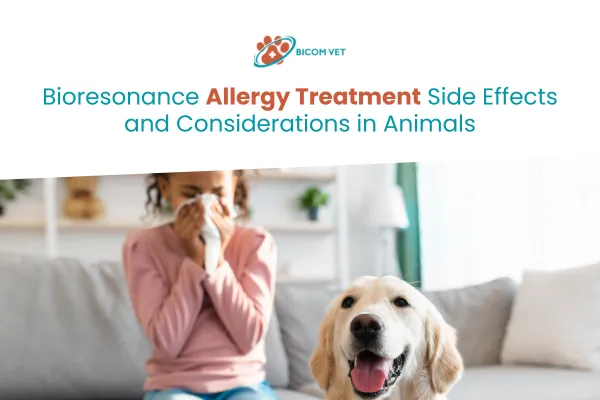
Bioresonance Allergy Treatment Side Effects in Animals Guide
Bioresonance Allergy Treatment Side Effects and Considerations in Animals
As pet owners increasingly seek alternative therapeutic approaches for their animals' health concerns, bioresonance allergy treatment has emerged as a promising non-invasive option. However, understanding the potential side effects and essential considerations is crucial for making informed decisions about your pet's care.
This comprehensive guide explores what you need to know about the safety of bioresonance therapy, helping you navigate this innovative treatment approach with confidence and clarity.
Understanding Bioresonance Allergy Treatment Safety
Bioresonance therapy utilizes electromagnetic frequencies to address imbalances in your pet's body, particularly targeting allergic reactions and sensitivities. Unlike conventional treatments that often involve medications with known side effects, bioresonance allergy treatment operates through a fundamentally different mechanism.
The therapy works by detecting and correcting frequency imbalances that may contribute to allergic responses. This approach focuses on restoring natural harmony within your pet's biological systems rather than suppressing symptoms.
Most veterinary professionals report that bioresonance therapy demonstrates an excellent safety profile compared to traditional allergy medications. The non-invasive nature of the treatment means there's no need for injections, oral medications, or surgical procedures.
Common Side Effects of Bioresonance Allergy Treatment
While bioresonance allergy treatment is generally well-tolerated, some animals may experience mild reactions as their bodies adjust to the therapeutic frequencies. Understanding these potential responses helps you monitor your pet appropriately.
Mild Detoxification Responses
Some pets may experience gentle detoxification symptoms during the initial treatment sessions. These responses typically indicate that the body is beginning to eliminate toxins and restore balance.
Common detoxification signs include:
Temporary changes in appetite
Mild lethargy for 24-48 hours post-treatment
Slight increase in water consumption
Brief digestive adjustments
These symptoms usually resolve within a few days as your pet's system adapts to the therapy.
Temporary Symptom Fluctuations
During the early stages of bioresonance allergy treatment, some animals may experience temporary fluctuations in their allergy symptoms. This phenomenon, known as a healing response, typically occurs as the body works to restore its balance.
You might notice slight increases in scratching, mild skin irritation, or temporary changes in behavior. These responses typically indicate that the therapy is engaging with your pet's immune system and should subside as treatment progresses.
Behavioral Changes
Some pets may display subtle behavioral changes following bioresonance sessions. These alterations often reflect the body's natural healing processes and adjustment to improved energy balance.
Possible behavioral observations include:
Increased or decreased activity levels
Changes in sleep patterns
Temporary restlessness or unusual calmness
Altered social interactions
Most behavioral changes are temporary and resolve as your pet adapts to the treatment protocol.
Important Considerations Before Starting Treatment
Several factors require careful consideration before beginning bioresonance allergy treatment for your pet. These considerations ensure the therapy is appropriate and safe for your animal's specific situation.
Current Health Status Assessment
A thorough health evaluation is essential before starting any bioresonance protocol. Your veterinarian should assess your pet's overall health, current medications, and any existing health issues.
Animals with certain conditions may require modified treatment approaches or additional monitoring. Pregnant animals, elderly pets, and those with compromised immune systems need special consideration.
Medication Interactions
While bioresonance therapy is generally compatible with conventional treatments, it is crucial to discuss all current medications with your veterinarian. Some medicines may influence how your pet responds to electromagnetic frequencies.
Your veterinary team can help determine the best approach for integrating bioresonance allergy treatment with existing therapeutic protocols.
Treatment Frequency and Duration
The frequency and duration of bioresonance sessions vary depending on the severity of your pet's condition and their individual response. Starting with a conservative approach allows for careful monitoring and adjustment as needed.
Most treatment protocols begin with more frequent sessions that gradually decrease as symptoms improve. This approach minimizes the risk of overwhelming your pet's system while maximizing therapeutic benefits.
Specific Considerations for Different Animals
Different species and individual animals may respond uniquely to bioresonance allergy treatment. Understanding these variations helps ensure that you receive appropriate care for your specific pet.
Canine Considerations
Dogs generally tolerate bioresonance therapy very well, with minimal side effects reported. However, highly sensitive dogs or those with severe allergies may require a gradual introduction to the treatment.
Larger dogs may need longer treatment sessions, while smaller breeds often respond more quickly to the frequencies. Age considerations include modified protocols for puppies and senior dogs.
Feline Sensitivities
Cats can be susceptible to environmental changes and may show more pronounced initial responses to bioresonance treatment. Starting with shorter sessions and gradually increasing duration often works best for feline patients.
Some cats may experience temporary changes in litter box habits or appetite during the adjustment period. These changes typically resolve within a few days.
Equine Applications
Horses receiving bioresonance allergy treatment may show subtle changes in behavior or performance during the initial treatment phases. These responses usually indicate the therapy is engaging with their systems.
Working horses may require modified training schedules during the early treatment period to accommodate any temporary fluctuations in energy.
Monitoring Your Pet During Treatment
Proper monitoring ensures your pet's safety and helps optimize treatment outcomes. Keeping detailed records of your pet's responses helps your veterinary team adjust protocols as needed.
Signs to Watch For
Monitor your pet for any unusual symptoms or behaviors following bioresonance sessions. While severe adverse reactions are rare, staying vigilant ensures prompt intervention if needed.
Contact your veterinarian if you notice:
Prolonged lethargy beyond 48 hours
Significant appetite changes lasting more than a few days
Unusual behavioral changes that persist
Worsening of original symptoms beyond the expected adjustment period
Communication with Your Veterinary Team
Maintaining open communication with your bioresonance vet team is essential for successful treatment outcomes. Regular check-ins enable protocol adjustments and ensure your pet's ongoing well-being.
Your veterinary team can provide guidance on distinguishing between normal and concerning responses, and help you navigate any questions that arise during treatment.
Maximizing Treatment Safety and Effectiveness
Several strategies can help maximize the safety and effectiveness of bioresonance allergy treatment for your pet. These approaches support your animal's natural healing processes while minimizing potential side effects.
Preparation and Aftercare
Proper preparation and aftercare support your pet's response to bioresonance therapy. Ensuring your pet is well-hydrated and comfortable before sessions helps optimize treatment outcomes.
After treatment, providing a quiet environment for rest and recovery supports the healing process. Avoiding stressful activities immediately following sessions allows your pet to fully integrate the therapeutic benefits.
Lifestyle Considerations
Supporting your pet's overall health through proper nutrition, exercise, and stress management enhances the effectiveness of bioresonance treatment. A holistic approach to wellness creates the best foundation for healing.
Environmental modifications, such as reducing allergen exposure and maintaining clean living spaces, complement bioresonance therapy and support long-term success.
Making Informed Decisions About Bioresonance Therapy
Understanding the side effects and considerations of bioresonance allergy treatment empowers you to make informed decisions about your pet's care. This knowledge helps you work effectively with your veterinary team to achieve the best possible outcomes.
The generally mild nature of side effects, combined with the non-invasive approach of bioresonance therapy, makes it an attractive option for many pet owners seeking alternative solutions for managing allergies.
When considering bioresonance allergy treatment, consult with qualified veterinary professionals to discuss your pet's specific needs and circumstances. This collaborative approach ensures that the therapy is tailored to your animal's needs and is safe for them.
Ready to explore bioresonance allergy treatment for your pet? Contact experienced veterinary professionals who can assess your animal's suitability for this innovative therapy and guide you through the treatment process safely and effectively.
Frequently Asked Questions
1. How long do mild reactions typically last after electromagnetic frequency therapy?
Most mild reactions, such as temporary lethargy or appetite change,s resolve within 24-48 hours as your pet's system adjusts to the treatment. If symptoms persist beyond this timeframe, consult your veterinarian for guidance.
2. Can my pet receive regular medications while undergoing frequency-based therapy?
Yes, electromagnetic frequency therapy is generally compatible with conventional medications, though your veterinarian should review all current treatments. Open communication with your veterinary team ensures safe integration of both approaches.
3. Are there specific animals that should be avoided from this type of holistic therapy?
While most animals tolerate frequency therapy well, pregnant pets, those with severe health conditions, or animals with pacemakers may require special consideration. A thorough health assessment determines suitability for each case.
4. What should I do if my pet seems more restless after frequent sessions?
Temporary restlessness is a normal adjustment response that typically subsides within a few days of treatment. Provide a quiet and comfortable environment, and monitor your pet's behavior for any concerning changes.
5. How often should I schedule follow-up appointments during electromagnetic therapy?
Treatment frequency varies based on your pet's condition and response; however, most protocols begin with more frequent sessions that gradually decrease. Your veterinary team will establish an appropriate schedule based on your pet's individual needs.


Facebook
Instagram
Mail